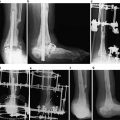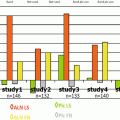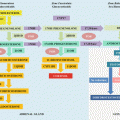Drug
Rationale
Study design
Follow-up
Main Results
Side effects
Metformin [25]
Metformin plus placebo × metformin plus exenatide
Cohort. N = 150
82 weeks
Lower Hba1c and weight reduction with exenatide
More nausea and vomiting with exenatide
Sulfonylurea [27]
Sulfonylurea plus placebo × sulfonylurea plus exenatide
Randomized, double-blind. N = 337
30 weeks
Lower Hba1c and weight reduction with exenatide
More nausea, vomiting, diarrhea, and dose-dependent hypoglycemia with exenatide
Glitazones [34]
Exenatide plus glitazones × exenatide or glitazones plus metformin
Randomized, open. N = 137
20 weeks
Lower HbA1c and improved insulin sensitivity with exenatide plus glitazone
More nausea and vomiting with exenatide
Glargin insulin [36]
Exenatide × glargin insulin plus metformin or pioglitazone
Randomized, double-blind. N = 262
24 weeks
Weight loss and no hypoglycemia with exenatide: no HbA1c differences
More nausea, vomiting, diarrhea with exenatide
Table 30.2
Head-to-head trials: exenatide × other drugs for T2DM
Drug | Rationale | Study design | Follow-up | Main results | Side effects |
|---|---|---|---|---|---|
Sulfonylurea [28] | Exenatide × sulfonylurea plus metformin | Randomized, single-blind. N = 1,029 | 236 weeks | Lower Hab1c, weight loss, and less hypoglycemia with exenatide | More nausea, vomiting, diarrhea, and dropouts with exenatide. |
Pioglitazone [26] | Exenatide plus metformin × pioglitazone plus metformin | Randomized, double-blind. N = 491 | 26 weeks | Lower Hba1c and weight loss with exenatide | More nausea and diarrhea with exenatide. |
Sitagliptin [26] | Exenatide plus metformin × sitagliptin plus metformin | Randomized, double-blind. N = 491 | 26 weeks | Lower Hba1c and weight loss with exenatide | More nausea and diarrhea with exenatide |
Insulin, glargin [35] | Exenatide plus metformin × glargin insulin plus metformin | Randomized, single-blind. N = 69 | 52 weeks | No differences in HbA1c between drugs. Weight loss and improved insulin secretion with exenatide | More nausea, vomiting, diarrhea with exenatide |
Insulin, glargin [38] | Switching glargin insulin plus metformin for exenatide plus metformin | Randomized, open. N = 49 | 16 weeks | 61 % patients could maintain a good glycemic control after switching from glargin insulin to exenatide | More nausea and vomiting with exenatide |
Premixed insulin [37] | Exenatide plus metformin × premixed insulin plus metformin | Randomized, open. N = 501 | 52 weeks | No differences in HbA1c between drugs. Weight loss and less hypoglycemia with exenatide | More nausea, vomiting, diarrhea, and dropouts with exenatide |
Compared with insulin glargine and premixed insulin, exenatide was no less effective in achieving good glycemic control, with the best results in terms of hypoglycemia risk and weight loss. Once again, the patients using exenatide showed more side effects, especially nausea and vomiting [35–37].
A small trial evaluated the possibility of replacing glargin insulin with exenatide in type 2 diabetes patients. 61 % of patients who switched drugs were able to maintain good glycemic control. A shorter duration of type 2 diabetes and the use of low doses of insulin were significantly associated with a greater chance of success [38].
Liraglutide
Liraglutide was the second GLP-1 RA approved for use in type 2 diabetes. The native hormone has been modified to develop a compound with pharmacokinetic properties suitable for once daily administration.
It is available for subcutaneous use in a single daily dose. It exhibits a 97 % structural similarity to endogenous GLP-1, and has a half-life of approximately 13 h. This pharmacokinetic profile is due to the combination of prolonged absorption at the site of injection, a rate of albumin binding greater than 98 % and a high resistance to degradation by DPP-IV [39].
The trials for the approval of liraglutide comprised the LEAD program (Liraglutide Effect and Action on Diabetes), which included six large randomized controlled trials, with a total of over 4,000 patients, conducted in over 600 centers in 40 countries [40–45]. The objectives of the LEAD studies were to evaluate the efficacy and safety of liraglutide and compare it with other treatments available for type 2 diabetes. The summary of the studies is found in Table 30.3.
Table 30.3
Summary of LEAD trials
Trial | Liraglutide-associated drug | Comparison | Study design | Main end point/follow-up | Summary |
|---|---|---|---|---|---|
LEAD 1 [42] | Glimepiride | Liraglutide versus rosiglatozone or placebo plus glimepiride | Double-blind, randomized. N = 1,041 | HbA1c—26 weeks | Lower HbA1c with liraglutide (1.2 or 1.8 mg) than placebo or rosiglitazone when added to glimepiride |
LEAD 2 [40] | Metformim | Liraglutide plus metformin versus metformin plus glimepiride | Randomized, controlled, open. N = 1,091 | HbA1c—26 weeks | Lower HbA1c with liraglutide than glimepiride when added to metformin |
LEAD 3 [43] | Placebo | Glimepiride 8 mg versus liraglutide 1.2 or 1.8 mg plus placebo | Double-blind, randomized. N = 746 | HbA1c—52 weeks | Lower HbA1c and with liraglutide than glimepiride. More side effects with liraglutide |
LEAD 4 [45] | Metformin plus rosiglitazone | Liraglutide 1.2/1.8 mg versus placebo metformin, plus rosiglitazone and metformin | Double-blind, randomized. N = 533 | HbA1c—26 weeks | Lower HbA1c, increase in C peptide and dose-dependent weight loss with liraglutide than placebo |
LEAD 5 [44] | Metformin plus glimepiride | Liraglutide versus placebo versus glargin insulin plus metformin and glimepiride | Randomized, open, multicenter. N = 581 | HbA1c—26 weeks | Lower HbA1c, more weight loss, and less hypoglycemia with liraglutide. More side effects with liraglutide |
LEAD 6 [41] | Metformin, glimepiride, or both drugs | Liraglutide versus exenatide plus metformin, glimepiride or both drugs | Randomized, open, multicenter. N = 464 | HbA1c—26 weeks | Liraglutide reduced mean HbA1c significantly more than exenatide |
In relation to glycemic control, a significant and sustained HbA1c reduction of around 1.1–1.5 % was obtained in all studies. Liraglutide also showed a lower risk of hypoglycemia. All the LEAD studies showed a significant reduction in body weight of approximately 1.0–3.2 kg. A reduction in systolic blood pressure of about 2.1–6.7 mmHg was also observed. The possibility of an improvement in metabolic control associated with decreased body weight is of paramount importance in the current scenario of a growing global prevalence of obesity and the forecast significant increase in the number of diabetics.
Liraglutide is, in general, well tolerated. The most common adverse events were related to the gastrointestinal tract, including nausea, vomiting, and diarrhea, occurring in 10–40 % of patients participating in the studies cited above. Most cases were mild and transient, occurring early in treatment and rarely resulting in discontinuation of the medication.
The effect on thyroid C cell in humans is unclear, since there are fewer C thyroid cells than in mice and the expression of GLP-1 receptors on those cells is very low [46]. A study was carried out to compare the levels of plasma calcitonin in humans using liraglutide versus a control group, and after two years of follow-up there were no consistent differences between the two groups, supporting the hypothesis that this drug does not increase the risk of follicular thyroid carcinoma in humans [47]. Until more definite data become available, the U.S. Food and Drug Administration (FDA) does not recommend its use in patients with a past or family history of medullary carcinoma of the thyroid or multiple endocrine neoplasia (MEN) type 2A or 2B.
Among the LEAD studies, there were seven cases of pancreatitis reported in 4,257 patients using liraglutide, while in the comparator group there were 2 cases. The small number of events hinders a proper conclusion involving causality. As previously mentioned, it is well established that diabetic patients show an increased risk of pancreatitis, a risk that can be three times higher than in the nondiabetic population, complicating data interpretation. The current recommendation of the FDA is to monitor the occurrence of abdominal pain and to immediately suspend the use of liraglutide use if pancreatitis is suspected.
In the LEAD studies, liraglutide was associated with a lower rate of major cardiovascular events compared with other therapies which served as comparators. It is possible that the beneficial effects of liraglutide on glycemic control, weight loss, and reduction in systolic blood pressure contributed to this result, but long-term studies are still being conducted to establish whether there are any real cardiovascular benefits.
Liraglutide is used initially at a dose of 0.6 mg, with progression to 1.2 mg. This gradual progression helps to minimize the side effects. To achieve a better glycemic control, it can be used at a dose of 1.8 mg. There is no need for dose adjustment according to age, gender, or ethnicity. It should be used with caution in patients with liver and kidney failure, although its phamacokynetics do not change significantly in the presence of advanced renal failure.
The Role of GLP1 RA in the Modern Treatment of T2DM
At the 2012 ADA/EASD position statement the indications for incretin-based therapies were greatly expanded in comparison with the previous document. In patients poorly controlled despite a proper diet, physical activity, and monotherapy with metformin, if the main objectives are to achieve good glycemic control with a low risk of hypoglycemia and leading to weight loss, GLP1 RA should be the first choice, although the costs and potential side effects should always be taken into consideration [48].
GLP-1 RA in the Treatment of Obesity
The World Health Organization estimates that the worldwide prevalence of overweight is 1.5 million adults, while 500 million are believed to be obese. It is known that the risk of developing T2DM is directly proportional to excessive body weight, increasing approximately threefold in overweight patients and 20-fold in obese ones when compared to individuals with a normal body mass index (BMI) [49]. Obesity, particularly when associated with increased visceral adipose tissue, is an independent risk factor for coronary heart disease, contributing to a substantial increase in cardiovascular morbidity and mortality. Considering that there is a global trend towards an increased prevalence of obesity and T2DM and that the therapies most widely available for T2DM induce weight gain (insulins, thiazolinediones, sulfonylureas), the prospect of drugs that act in glycemic control, leading to a better metabolic profile, is quite encouraging.
Stay updated, free articles. Join our Telegram channel

Full access? Get Clinical Tree






